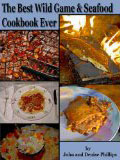Where Ducks Hide with Outdoor Writer John E. Phillips
Day 3: Knowing the Best Shooting Times to Take Ducks
Editor’s Note: If you’re tired of the competition and expenses involved when hunting on the big reservoirs and well-known duck marshes, here’s a surefire way to locate good duck hunting not too far from home by hunting smaller waters like potholes, beaver ponds and swamps.
  The best shooting time is usually being ready in a feeding area when the birds fly from their roosts early in the morning. You also can get some shooting during the last few hours of daylight by staking out feeding areas. At such times, the birds fly in from their daytime loafing for their last feed of the day. Still another possibility is to wait near or in a roosting area and take birds that are moving to it after the evening feeding period. Another possibility is to wait in a daytime loafing area. In such places, the birds don’t come in a short massed flight. Rather, they come in singly, in pairs or in small flocks. Most loafing areas are difficult to approach, because the birds often choose them for their isolation and security. Approaching a loafing area when the birds are already there is difficult. The best way is to get there before they do. The best shooting time is usually being ready in a feeding area when the birds fly from their roosts early in the morning. You also can get some shooting during the last few hours of daylight by staking out feeding areas. At such times, the birds fly in from their daytime loafing for their last feed of the day. Still another possibility is to wait near or in a roosting area and take birds that are moving to it after the evening feeding period. Another possibility is to wait in a daytime loafing area. In such places, the birds don’t come in a short massed flight. Rather, they come in singly, in pairs or in small flocks. Most loafing areas are difficult to approach, because the birds often choose them for their isolation and security. Approaching a loafing area when the birds are already there is difficult. The best way is to get there before they do.
Keith McCutcheon, a wildlife biologist specializing in waterfowl, had a lot to say about how to hunt. “Feeding areas are the most productive – especially in the early morning and right after bad weather. Sometimes ducks prefer to feed at night, but when the weather is so bad that they can’t, they get excited and come in strong to feed at first light. If you find a single place where the birds are both roosting and feeding, you’ll have a hot spot for duck hunting. Ducks often may roost right where they feed.”
  Gary Moody, the chief of the Wildlife Section for the State of Alabama, says a hunter who does his research and locates separate feeding and roosting or loafing places may find that his best shooting occurs between these two locations that provide fine pass shooting. Moody explains that beaver-pond hunting for wood ducks is usually good for several years after the beavers dam a stream. The many hollow trees standing in or close to the water provide nesting and roosting cavities. As these trees fall, nesting holes are eliminated. Gary Moody, the chief of the Wildlife Section for the State of Alabama, says a hunter who does his research and locates separate feeding and roosting or loafing places may find that his best shooting occurs between these two locations that provide fine pass shooting. Moody explains that beaver-pond hunting for wood ducks is usually good for several years after the beavers dam a stream. The many hollow trees standing in or close to the water provide nesting and roosting cavities. As these trees fall, nesting holes are eliminated.
On these small ponds and sloughs, one hunter may have exclusive hunting rights either because he’s the only one the landowner permits to hunt, or he owns the site. In such cases, he definitely can limit the shooting. Shooting as often as 3 days a week may not be detrimental, if large flights of migrating birds continue to come to the site. But if you’re hunting mostly resident birds, limit yourself to only one or two sessions per week. If you shoot too much, you may drive the birds away.
 To get John E. and Denise Phillips’ Kindle eBook, “The Best Wild Game & Seafood Cookbook Ever: 350 Southern Recipes for Deer, Turkey, Fish, Seafood Small Game and Birds,” click here. Or, go to http://www.amazon.com/kindle-ebooks, type in the names of the books, and download them to your Kindle, and/or download a Kindle app for your iPad, SmartPhone or computer. To get John E. and Denise Phillips’ Kindle eBook, “The Best Wild Game & Seafood Cookbook Ever: 350 Southern Recipes for Deer, Turkey, Fish, Seafood Small Game and Birds,” click here. Or, go to http://www.amazon.com/kindle-ebooks, type in the names of the books, and download them to your Kindle, and/or download a Kindle app for your iPad, SmartPhone or computer.
About the Author
John Phillips, winner of the 2012 Homer Circle Fishing Award for outstanding fishing writer by the American Sportfishing Association (ASA) and the Professional Outdoor Media Association (POMA), the 2008 Crossbow Communicator of the year and the 2007 Legendary Communicator chosen for induction into the National Fresh Water Hall of Fame, is a freelance writer (over 6,000 magazine articles for about 100 magazines and several thousand newspaper columns published), magazine editor, photographer for print media as well as industry catalogues (over 25,000 photos published), lecturer, outdoor consultant, marketing consultant, book author and daily internet content provider with an overview of the outdoors. Click here for more information and a list of all the books available from John E. Phillips.
|
